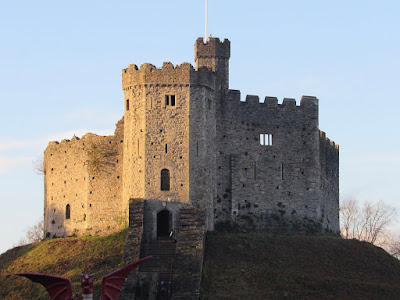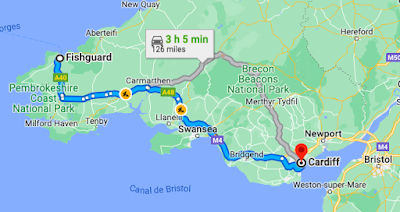
If you're spending only a day in Cardiff, the capital of Wales, you will want to see the Cardiff Castle. One among some 300 in the country, the 2,000-year-old castle has seen many faces and reconstructions. The Romans were the original builders of a series of forts. The Normans took over in 11th century and added fortifications and the keep (below). The medieval Lords of Glamorgan began work on the House during the 15th century.
In the 19th century, the Bute family, among the wealthiest in the world at the time, transformed the castle into the opulent Victorian Gothic home it is today. (They also tore down the medieval city and built a new one with arcades for shopping. ) During World War II (1939-45) the walls which surround the Castle were used as air raid shelters, which provided a place of safety for 2,000 Cardiff citizens during the German bombings with the layers of masonry and earth banks above.
In 1947 the Bute family gave the castle to the City of Cardiff, which is now open to the public visits as well as for weddings and parties. That's quite a life for a castle that has literally seen the face of ancient, medieval, and modern history.
The Bute Family
The second Marquess of Bute who through a coal exportation business turned Cardiff into the world's greatest port. He had acquired the castle through marriage in 1766. His son, John, the acquired the castle and his father's fortune in the 1860s. He was reputedly the richest man in the world, and he spent much of his wealth in decorating the castle.
John was a learned man, a Biblical scholar, and a polyglot of about 20 languages including Latin, Greek, and Hebrew. He was obsessed with medieval life, and he re-created it in his castle in collaboration with an architectural genius named William Burges. The gothic towers have lavish and opulent interiors and the castle rooms have an abundance of murals, stained glass, marble, gilding, and elaborate wood carvings--each with a special theme with Mediterranean, Italian, and Arabic decoration. Many unfinished projects were completed by the 4th Marquess of Bute.
For 25
years, the Castle was home to the National College of Music and Drama ,
and since 1974 it has become one of Wales’ most popular visitor
attractions.
Below are examples of the clock tower and some of the rooms and special features of the castle. For one-minute video explanations of various rooms with more dynamic photos, click here on the Castle's website.


Ceilings were important to the architect and they provide a different look from what one might expect in a castle let alone any modern building.

Here are some special highlights of the castle in the form of sculptures and murals. They also reflect the third marquess' scholarship of history and language.


This is a table setting of Victorian Wales. The castle currently hosts weddings and parties that provide similar beautiful tables aimed at delighting the eye.

The Roof Garden sports a statue of the Virgin and some copies of ancient Roman wood warmers that the Marquess saw on his journeys to Italy.
Even the bedroom and bath spare no lack of decorations

Surrounding the castle grounds is the unique Animal Wall. It originally comprised eight animals placed on the wall from the South Gate entrance to the Clock Tower. They were moved to their present position in 1928. They were carved by the Thomas Nicholls of Lambeth between 1887 and 1889 and are distinguished by their glass eyes.
Another group of animals was added in 1928-30 by Alexander Carrick of Edinburgh, which include the lynx, vulture, beaver, leopard, racoon, ant-eater and pelican.
One other note on the fortification around the castle illustrates its history. A portion of the wall that is uncovered reveals the Normans' original wall.
Resources
Cardiff Castle -- https://www.cardiffcastle.com/history/













































